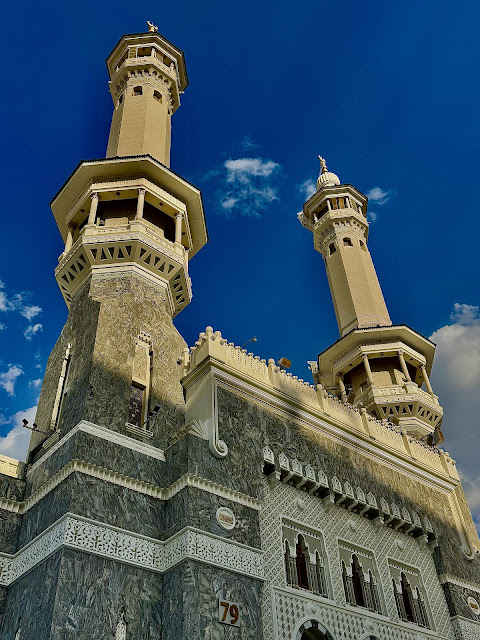Hajj Al - Tamattu
Hajj Al-Tamattu’
Day 0 (7th of Dhul-Hijjah)
Ihram (State of consecration):
• Ghusl (bath): Cleanse your body with a bath.
• Dress: Men wear two unstitched white cloths (Ihram), while women wear
modest clothing.
• Niyyah (intention): Declare your intention to enter Ihram for Umrah.
• After assuming the clothing of ihram, offer two rakah of sunnah prayer
with the intention of ihram. It is preferable to recite Surah Kafirun in the
first rakah and Surah Ikhlas in second. This prayer, however, should not
be offered at makruh or haram times, nor should it be offered by
menstruating women.
• Talbiyah: Recite the Talbiyah: "Labbayk Allahumma Labbayk, Labbayk
La Shareeka Laka Labbayk. Innal-hamda wan-ni'mata Laka wal-mulk,
La Shareeka Lak." (Here I am, O Allah, here I am. Here I am, You have
no partner, here I am. Indeed, all praise, grace and sovereignty belong
to You. You have no partner).
Umrah of Arrival in Makkah:
• Perform Wudu and then head towards Masjid al-Haram reciting Talbiyah.
• Sighting of Kaabah - First time you lay eye on the Kaabah is a time of
acceptance of Dua. Hence, one particularly noteworthy dua, as
recommended by Imam Abu Hanifah (may the mercy of Allah be upon
him), is to ask that all future duas, wherever and whenever they might
be made, be accepted.
Tawaf (Circumambulation of the Ka'bah):
• Start from the Black Stone: Begin Tawaf from the Black Stone.
• Seven rounds: Circle the Ka'bah seven times counter-clockwise. Raml
(Sunnah) : Men may perform Raml (brisk walking) in the first three rounds.
• Two Rak'ahs: Pray two Rak'ahs behind Maqam Ibrahim (the Station of
Abraham) after Tawaf.
Sa'i (Walking between Safa and Marwa):
• Start from Safa: Begin Sa'i from the hill of Safa.
• Seven rounds: Walk seven times between Safa and Marwa.
Coming out of State of Ihram
• After completing Umrah, have your hair cut or your head shaved (since
you are performing Hajj Tamattu). Your Umrah component of Hajj is now
complete.
Day 1 (8th of Dhul-Hijjah)
New Ihram (State of consecration):
• Ghusl (bath): Cleanse your body with a bath.
• Dress: Men wear two unstitched white cloths (Ihram), while women
wear modest clothing.
• Niyyah (intention): Declare your intention to enter Ihram for Hajj.
• Hajj Tamattu Oh Allah, I intend Hajj. Make it easy for me and accept
from me.
• After assuming the clothing of ihram, offer two rakah of sunnah prayer
with the intention of ihram. It is preferable to recite Surah Kafirun in the
first rakah and Surah Ikhlas in second. This prayer, however, should not
be offered at makruh or haram times, nor should it be offered by menstruating women.
• Talbiyah: Recite the Talbiyah: "Labbayk Allahumma Labbayk, Labbayk
La Shareeka Laka Labbayk. Innal-hamda wan-ni'mata Laka wal-mulk,
La Shareeka Lak." (Here I am, O Allah, here I am. Here I am, You have
no partner, here I am. Indeed, all praise, grace and sovereignty belong
to You. You have no partner).
Head to Mina, a sprawling tent city
• Spend the day in Mina, set out the next morning at dawn. Most of the
time in Mina is spent in prayer and remembering Allah.
• It is mustahabb (recommended) to perform five prayers (Dhuhr, Asr,
Maghrib, Isha, and Fajr) in Mina.• Prayers will not be combined, but they will be shortened. Therefore, each prayer will be prayed at its proper time, but Dhuhr, Asr, and Isha will be shortened from four rakah to two.
• Pray all of your sunnahs (and nafl) as your time in Mina constitutes
valuable free time for the worship of Allah (Glorious and Exalted). The
following is a suggested schedule of prayers:
• Outside of these prayers, spend your free time engaged in dhikr,
recitation of the Holy Qur’an, sending salawat (salutations) on the
Prophet (peace and blessings be upon him), glorifying Allah (Glorious
and Exalted), and resting, if necessary, for the next day in Arafah.
Day 2 (9th of Dhul-Hijjah)
Spend the day at Arafat
• The Day of Arafat one of the most important days (Pillar of Hajj)
• Perform wudu before the time for Dhuhr begins.
• Perform Dhuhr in congregation. Even if it is Friday, Jumuah will not be
offered. Instead the group will pray Dhuhr. Also, Asr will not be
combined with Dhuhr.
• Spend your time in ibadah (worship) and in the remembrance of Allah
(Glorious and Exalted). This period of time (from Dhuhr to the beginning
of Maghrib) is known as the wuquf of Arafah. It is the essence of the
journey and is the key act of Hajj.
• Perform Asr in congregation at its time.
• Engage in dhikr and dua until sunset.
Collect pebbles at Muzdalifah
• Before sunset move to Muzdalifah where spend the night under the stars.
• Call the adhan and one iqamah.
• Pray the 3 fard of Maghrib (as a group).
• Pray the 2 fard of Isha (without a second iqamah, as a group).
• Pray the sunnah of Maghrib (individually).
• Pray the sunnah of Isha (individually).
• Pray Witr (individually).
• The above sequence is usually performed in small groups (due to
space limitations). If you pray individually, however, the above
sequence will still be followed.
• Collect pebbles - 70 in total per person (7 + 21 x 3) + ?some extras
• Stay overnight in Muzdalifah
• Spend the night in Ibadah. Very blessed and virtuous time.
• Departing again just before sunrise after performing Fajr prayer.
Day 3 (10th of Dhul-Hijjah)
Four major responsibilities:
Throw stones at the pillar
• The longest day of the pilgrimage
• The 10th of Dhul-Hijjah is Eid al-Adha
• Heading back to Mina before dawn from Muzdalifah
• Continue reciting Talbiyah
• Once in Mina - first rami, throw seven pebbles at the largest of three
columns known as Jamarat. (Jamarat Al Aqabah) Takbir: Say Bismillahi
Allah Akbar with each throw
• Walk immediately after stoning, don’t hold back (Sunnah) and no Dua is
made after pelting.
• After throwing of stones - Talbiyah of Hajj ends
Animal Sacrifice
• Slaughter sheep
Halaq
• Shave hair and remove their ihram clothes.
• Women: Trim a small portion of their hair.
Tawaf Ziyarah
• Proceed to Mecca to perform Tawaf Ziyarah and sa’ee
• Also two rakah nfil of Umrah
• Rest for sometime at Makkah hotel
• Return to campsite in Mina in the evening.
Day 4, 5 & 6 (11th, 12th and 13th of Dhul Hijjah)
Days of Tashreeq
• Mina: Stay in Mina and stone the three Jamarat each day
• Ramee of Jamarat not Wajib on 13th but recommended
• Ramee done between Zuhur and Maghreb each day
• Make supplications after first and second Jamarat but not after Jamarat
Aqabah.
• Tawaf al-Wida' (Farewell Tawaf): Makkah: Perform Tawaf al-Wida' before leaving Makkah.
Important Notes:
# Two Pillars of Hajj (according to Hanafi Fiqh)
The main components of Hajj are the two pillars, which are the essential acts that make the pilgrimage valid. These include:
• Mount 'Arafah
The plains of Arafah where pilgrims spend the Day of Arafah, asking Allah for forgiveness.
• Tawaf Ziyarah Which is the Tawaaf on the 10th of Dhul-Hijjah after
pelting, slaughtering and shaving or trimming.
# Rules of Ihram
• It’s very important to note that when you are in a state of Ihram, you are
not permitted to smoke, swear, shave, clip your nails, or engage in
any form of sexual relations. Fighting and arguments are also forbidden, and participants are prohibited from hunting, killing, or
unjustifiably breaking anything. You must also avoid scented
products such as perfumes, moisturisers, makeup, or soaps. You
may, however, substitute them for unscented toiletries which are
permissible to use.
# Obligatory acts of Hajj
The obligatory actions of Hajj are seven:
1. Entering ihram at the appropriate miqat, i.e., one should enter ihram from
the miqat. As for ihram itself, it is an essential part of Hajj.
2. Standing in ‘Arafah until sunset, for the one who reaches there by day.
3. Staying overnight in Mina during the days of at-Tashriq (the 11th, 12th and
13th of Dhu’l-Hijjah)
4. Staying overnight in Muzdalifah until after halfway through the night.
5. Stoning the Jamarat in the right sequence.
6. Shaving the head or cutting the hair.
7. Farewell Tawaf (tawaf al-wada‘).









Comments
Post a Comment